Text
You’re lying - those are way cooler than dumb fireworks!
I really don’t like fireworks. They’re environmentally damaging, loud, and they hide the stars!
So yeah, July 4th wasn’t too happy for me.
WANT MORE? GET YOUR HEAD STUCK IN THE STARS AT MY BLOG!

A camera on the Vosges mountains in France captured these surprising “fireworks” above the horizon. Generated over intense thunderstorms, these brief and mysterious flashes have come to be known as red sprites. The transient luminous events are caused by electrical breakdown at altitudes of 50 to 100 kilometers. That puts them in the mesophere, the coldest layer of planet Earth's atmosphere. The glow beneath the sprites is from lightening under the clouds.
On the right, the video frames have captured another summertime apparition from the mesophere. The silvery veins of light are polar mesospheric clouds. Also known as noctilucent or night shining clouds, the icy clouds still reflect the sunlight when the Sun is below the horizon.
Image Credit & Copyright: Stephane Vetter (TWAN, Nuits sacrees)
137 notes
·
View notes
Photo
Omg that’s hilarious xD
Cuz the way the second equation is written assumes that the c^2 in the mass-energy equivalence equation is actually the c^2 from the Pythagorean Theorem when it’s actually just the speed of light (squared, since c IS the speed of light).
I do love the Pythagorean Theorem though, even though (don’t come after me) I prefer the version where you take the square root of both sides so it’s c = sqrt(a^2 + b^2). It’s just easier!
Nerd rant, over.
(Also, can you imagine Einstein, Hawking, and Neil being friends!? It’s like my dream come true)
WANT MORE? GET YOUR HEAD STUCK IN THE STARS AT MY BLOG!

Genius?
#einstein#neil degrasse tyson#stephen hawking#sciencememe#pythagorean theorem#mass-energyequivalenceequation
713 notes
·
View notes
Photo
Neptune!
Mercury will always be my favorite planet (closest to the Sun, underappreciated, proved Einstein’s general relativity, among other things) but I think Neptune’s the most beautiful. Look at that hue!
WANT MORE? GET YOUR HEAD STUCK IN THE STARS AT MY BLOG!
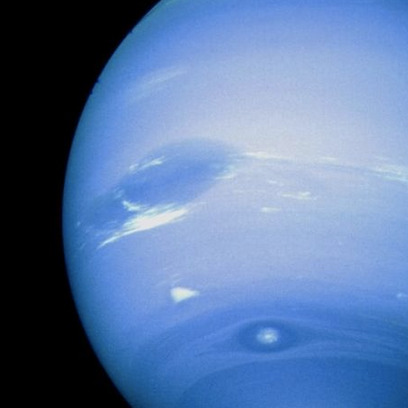
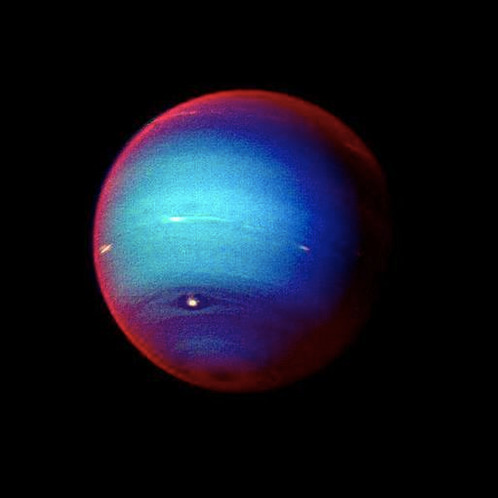


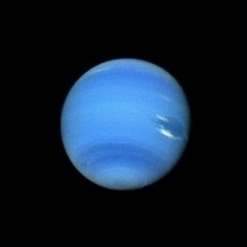

neptune.
44K notes
·
View notes
Photo
Escape velocity!!!!!!!
I.e. the velocity that an object must attain before being able to resist an object’s gravitational pull and escape it’s influence.

Please get this.
189 notes
·
View notes
Photo
Honestly I don’t really understand why they didn’t call the APOLLO missions the ARTEMIS missions! Artemis is the greek goddess of the moon, not Apollo xD
Dat rocket does look cool though. I prefer posting about astrophysics, but I’m having a lazy day and rockets are easy to find and cool to look at. Apologies for anyone expecting another post on stars or memes.
WANT MORE? GET YOUR HEAD STUCK IN THE STARS AT MY BLOG!

NASA Attaches First of 4 RS-25 Engines to Artemis I Rocket Stage : Engineers and technicians at NASA’s Michoud Assembly Facility in New Orleans have structurally mated the first of four RS-25 engines to the core stage for NASA’s Space Launch System (SLS) rocket that will help power the first Artemis mission to the Moon. (via NASA)
172 notes
·
View notes
Photo
Just so you guys know, the Galilean Moons aren’t Jupiter’s only moons. It has 79 confirmed moons.
Hey, at least they’re not all lonely.
Also, fun-fact, the Moon Europa is a big candidate for a “2nd Earth,” having an ocean under a shell of ice.
WANT MORE? GET YOUR HEAD STUCK IN THE STARS AT MY BLOG!

Over the span of a few hours, I collected images of Jupiter and its Galilean Moons. I labelled each one and you can see them move in their orbits! 🪐🪐🪐
Taken by me (Michelle Park) using the Slooh Canary Two telescope on June 3rd, 2020.
91 notes
·
View notes
Photo
I love supermassive black holes!!!
Expect this in the chapter about black holes lol
The relationship between SBHs and their host galaxies are so cool!
WANT MORE? GET YOUR HEAD STUCK IN THE STARS AT MY BLOG!
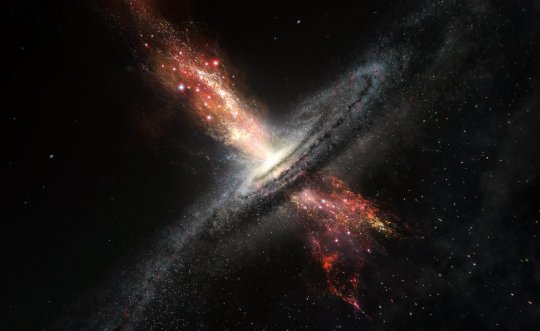


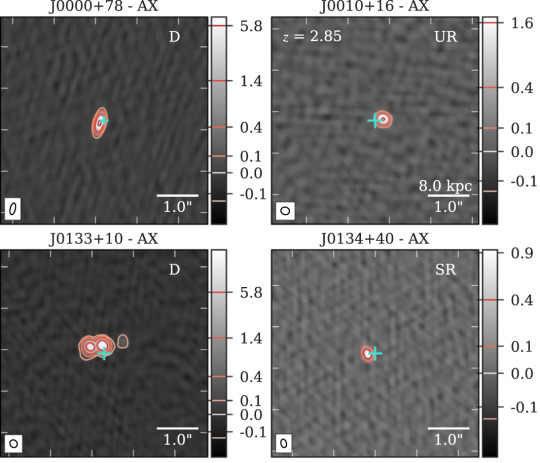
AAS NOVA
A Young Population of Hidden Jets
By Susanna Kohler
Looking for a fireworks show this 4th of July? Try checking out the distant universe, where powerful jets flung from supermassive black holes slam into their surroundings, lighting up the sky.
Though these jets are hidden behind shrouds of gas and dust, a new study has now revealed some of these young powerhouses.
A Galaxy–Black-Hole Connection
In the turbulent centers of active galaxies (active galactic nuclei, or AGN), gas and dust rains onto supermassive black holes of millions to billions of solar masses, triggering dramatic jets that plow into the surrounding matter and light up across the electromagnetic spectrum.
The growth of a supermassive black hole is thought to be closely tied to the evolution of its host galaxy, and feedback like these jets may provide that link. As the jets collide with the gas and dust surrounding the galaxy’s nucleus, they can trigger a range of effects — from shock waves that drive star formation, to gas removal that quenches star formation.
To better understand the connections between supermassive black holes and their host galaxies, we’d especially like to observe AGN at a time known as Cosmic Noon. This period occurred around 10 billion years ago and marks a time when star formation and supermassive black hole growth was at its strongest.
The Hidden World of Cosmic Noon
But there’s a catch: around Cosmic Noon, galaxies were heavily shrouded in thick gas and dust. This obscuring material makes it difficult for us to observe these systems in short wavelengths like optical and X-ray. Instead, we have to get creative by searching for our targets at other wavelengths.
Since AGN emission is absorbed by the surrounding dust and re-radiated in infrared, we can use infrared brightness to find obscured but luminous sources. To differentiate between hidden clumps of star formation and hidden AGN, we also look for a compact radio source — a signature that points to a jet emitted from a central black hole.
A team of scientists led by Pallavi Patil (University of Virginia and the National Radio Astronomy Observatory) has now gone on the hunt for these hidden sources at Cosmic Noon.
Newly-Triggered Jets Caught in the Act
Patil and collaborators observed a sample of 155 infrared-selected sources, following up with high-resolution imaging from the Jansky Very Large Array to identify compact radio sources. From their observations and modeling of the jets, the authors estimate these sources’ properties.
The authors find bright luminosities, small sizes, and high jet pressures — all of which suggest that we’ve caught newly-triggered jets in a short-lived, unique phase of AGN evolution where the jets are still embedded in the dense gas reservoirs of their hosts. The jets are expanding slowly because they have to work hard to push through the thick clouds of surrounding material. Over time, the jets will likely expand to larger scales and clear out the surrounding matter, causing the sources to evolve into more classical looking radio galaxies.
What’s next? The authors are currently working on a companion study to further explore the shapes of the jets and their immediate environments. These young, hidden sources will provide valuable insight into how supermassive black holes evolve alongside their host galaxies.
Citation
“High-resolution VLA Imaging of Obscured Quasars: Young Radio Jets Caught in a Dense ISM,” Pallavi Patil et al 2020 ApJ 896 18. doi:10.3847/1538-4357/ab9011
TOP IMAGE….Artist’s impression of a galaxy forming stars, as powerful jets that are flung from its central black hole collide with the surrounding matter. [ESO/M. Kornmesser]
CENTRE IMAGE….This composite image of Centaurus A shows an example of large-scale jets launched from an AGN, which can eventually extend far beyond the galaxy, as seen here. [ESO/WFI (Optical); MPIfR/ESO/APEX/A.Weiss et al. (Submillimetre); NASA/CXC/CfA/R.Kraft et al. (X-ray)]
LOWER IMAGE….The redshift distribution of the authors’ sample, based on spectroscopic redshifts of 71 sources. The sources span the period of peak star formation and black hole fueling around Cosmic Noon. [Patil et al. 2020]
BOTTOM IMAGE….The JVLA 10 GHz radio continuum observations for four sources in the authors’ sample. The cyan plus symbol marks the infrared-obtained source position. The color bars indicate flux in mJy/beam. [Adapted from Patil et al. 2020]
170 notes
·
View notes
Photo
Max Planck, you absolute boss
Btw there’s always something left in physics to discover. Going from nothing left to discover to quantum theory is a huge leap though, because quantum has PLENTY to figure out.
WANT MORE? GET YOUR HEAD STUCK IN THE STARS AT MY BLOG!

Oof
264 notes
·
View notes
Photo
It’s easy to forget that thousands of comets, asteroids, and meteors are near us everyday. They seem like such a rarity.
WANT MORE? GET YOUR HEAD STUCK IN THE STARS AT MY BLOG!

Cosmonaut Ivan Vagner obtained this image of the comet NEOWISE a few hours ago from the International Space Station. He says that the dust tail looks very good from there. It is worth enlarging the image.
via reddit
601 notes
·
View notes
Photo
This is why I’m so excited for the supernova chapter ehehe
It’s so amazing that this little dot growing a bit but still being little is a supernova!
WANT MORE? GET YOUR HEAD STUCK IN THE STARS AT MY BLOG!

This is the galaxy Messier 85! 🌌🌌🌌
Just last month, scientists found a supernova taking place! The event is named SN 2020nlb and has been continuously getting brighter. It is classified as a Type Ia supernova, which results from a white dwarf exploding within a binary star system. The brightness of this supernova can be used to calculate the distance to the galaxy! 🤩🤩🤩
Taken by me (Michelle Park) using the Slooh Canary Two telescope.
135 notes
·
View notes
Photo
Goddamn
We learned about the Uyuni Salt Flat in Marine Bio this year but the teacher never showed ANYTHING like this!!! I already thought that the band was beautiful, this just makes it 10 times more so. Welp, I know what to put next on my dream vacay list.
WANT MORE? GET YOUR HEAD STUCK IN THE STARS AT MY BLOG!

Night Sky Reflections from the Worlds Largest Mirror : What’s being reflected in the world’s largest mirror? Stars, galaxies, and a planet. Many of these stars are confined to the grand arch that runs across the image, an arch that is the central plane of our home Milky Way Galaxy. Inside the arch is another galaxy – the neighboring Large Magellanic Cloud (LMC). Stars that are individually visible include Antares on the far left and Sirius on the far right. The planet Jupiter shines brightly just below Antares. The featured picture is composed of 15 vertical frames taken consecutively over ten minutes from the Uyuni Salt Flat in Bolivia. Uyuni Salt Flat (Salar de Uyuni) is the largest salt flat on Earth and is so large and so extraordinarily flat that, after a rain, it can become the world’s largest mirror – spanning 130 kilometers. This expansive mirror was captured in early April reflecting each of the galaxies, stars, and planet mentioned above. via NASA
1K notes
·
View notes
Photo

THE LIFE OF A STAR: WHAT GOES AROUND, COMES AROUND
Previously on The Life of a Star, Chapter 6 ...
"But what happens after the shell is fused? We'll get back to that in Chapter 7, where we'll discuss White Dwarfs and Planetary Nebulae."
After a low-mass star loses its hydrogen core, it becomes a mighty Red Giant - the star contracts and then heats up again, igniting hydrogen shell fusion and swelling the star to epic proportions. That is, until the hydrogen shell and the helium core and all fused up, in which the helium shell will begin to fuse. Remember the last chapter, when I said that these stars don't have enough pressure to fuse the results of the triple-alpha process? Well, I wasn't lying.
And unlike the end of hydrogen fusion - where low-mass stars have a "2nd life" and continue fusing the elements - this means the end for our star. Now, due to the build-up of carbon and oxygen in the core (and the lack of enough pressure to fuse these elements), the star has run out of fuel. This cancels out gas pressure, which breaks the hydrostatic equilibrium. Gravity wins the constant battle within the star, and the core collapses.
The leftover core - tiny and hot - is called a Wolf-Rayet type star and squeezed into a volume one-millionth the size of the original star (Harvard). Now, why does the star stop here? If gravity overpowers the pressure inside the star, why does it not completely collapse into a black hole? Well, that's due to a little thing called electron degeneracy pressure. Basically, the Pauli exclusion principle states that "no two electrons with the same spin can occupy the same energy state in the same volume." Due to the core collapse, electrons are forced together. The Pauli exclusion principle predicts that these electrons, once having filled a lower energy state, will move to a higher one and begin to speed up. This creates pressure and prevents the core from further collapse. However, at a certain mass, this becomes impossible to maintain. White dwarfs have something called the Chandrasekhar limit, which states that white dwarfs cannot exist if their original mass is over 1.44 times the mass of the Sun. This is due to mass-radius relationships, something we'll discuss in the next chapter.
One of my favorite things about stars is the fact that they're a cycle - the death of some stars causes the birth of others. White dwarfs do this, too, by creating something we talked about in Chapter 3: Planetary Nebulae.
The collapsed Wolf-Rayet type star is extremely small, with high density and temperature. Streams of photons/energy/heat - stellar winds - push out the cooler outer layers of the dead star (Astronomy Notes). The core emits UV radiation, which ionizes the hydrogen and causes it to emit light, forming fluorescent and spherical clouds of gas and dust surrounding the hot white dwarf. These are Planetary Nebulae, which can later be clumped by gravity and spun to create a new star. The cycle continues (Uoregon).
The leftover core, the White Dwarf, is characterized by a low luminosity (due to the lack of new photons, which the star will start to lose by radiation) and a mass under about 1.44 times that of the Sun.
Due to the intense gravity, the White Dwarf (despite being very large in mass) has a radius comparable to that of the Earth. If you consult the density equation (d=m/v, which basically means that if you enlarge or shrink either the mass or the volume that the density will increase), White Dwarfs have enormous densities. The core is a compact of carbon and oxygen. Because the star is unable to fuse these elements, they kind of just ... sit there. Surrounding this is a shell of helium and a small hydrogen envelope. Some even have a very thin layer of carbon (Britannica).
However, the White Dwarf isn't the end for the star. There's one more stage for the star to go through before completely "dying": becoming a Black Dwarf.
After the core is left behind, there Is no fuel left to burn. That means no new energy production. However, the leftover heat from the contraction remains, and the star will begin to cool down. Higher mass White Dwarfs, due to having a smaller radius, radiate this away slower than the low-mass ones. There are two types of cooling: radiative and neutrino. Radiative cooling is simple: as the star gives off light and energy outward, it loses heat. Neutrino cooling is a bit more complex: at extremely hot temperatures, gamma radiation passes electrons, and this reaction creates a pair of neutrinos. Because neutrinos interact very weakly with matter, they escape the White Dwarf quickly, taking energy with them. It's also possible to have a hunch of crystal in the center of a Black Dwarf: "On the other hand, as a white dwarf cools, the ions can arrange themselves in an organized lattice structure when their temperature falls below a certain point. This is called crystallization and will release energy that delays the cooling time up to 30%." (Uoregon).
The White Dwarf will become a Black Dwarf after it radiates away all of its heat and becomes a cold, dark shell of its former self. Because it's radiated away all of its heat, it emits no light, hence the name. However, according to theoretical physics, there isn't a single Black Dwarf in the universe. Why? Because it should take at least a hundred million, billion years for a White Dwarf to cool down into a Black Dwarf. Because the universe is predicted to be around 13.7 billion years old, there hasn't been enough time for a single White Dwarf to completely cool down (space.com).
However, there's one last thing that can happen to a White Dwarf. And that's where things in this book will start to get explosive.
White Dwarfs in binary star systems (where two stars orbit around a center of mass, we'll touch on it more in Additional Topics) can undergo a Classical Nova. These supernovae occur in systems with one White Dwarf and one main-sequence star. If they orbit close enough, the White Dwarf will begin to pull the hydrogen and helium from the other star in what is called an Accretion Disk, what is to say a disk of plasma and particles which spiral inwards due to gravity and feeds one body off of another. The accretion of this plasma onto the surface of the White Dwarf increases pressure and temperature so much that fusion reactions spark and the outburst of energy ejects the shell in a burst of light - a nova (Cosmos).
This process doesn't end, however. It can repeat itself again and again in what is called a Recurrent Nova. We know the existence of these based on pictures of the same star system with expanding shells, the aftermath of recurrent novae. Because White Dwarfs are the most common star death in the universe, and most stars are in binary or multiple star systems, novae are fairly common (Uoregon).
Our discussion of novae will be an excellent transition into our next topic: supernovae! This will be the beginning of the end for the High-mass stars we talked about in Chapter 6, and we’ll even talk a little bit more about White Dwarf collisions and how they are related to supernovae, neutron stars, and more!
From here on out, stars are going to become much more dramatic - and all the cooler (well, not really)!
First - Chapter 1: An Introduction
Previous - Chapter 6: The End (But Not Really)
Next - Chapter 8: Why We’re Literally Made of Star-stuff (unpublished)
WANT MORE? GET YOUR HEAD STUCK IN THE STARS AT MY BLOG!
0 notes
Photo
Goregous :O
In the Life of a Star Chapter 11, Additional Topics, I’ve been thinking about putting in a section on solar flares and prominences. Maybe if I have enough room, I do love this photo.
WANT MORE? GET YOUR HEAD STUCK IN THE STARS AT MY BLOG!

Dramatic solar activity was going on last night and I was able to create a gif of this solar prominence! 🌞🌞🌞
Solar prominences are different from solar flares since solar prominences are mostly pulled in by the Sun’s gravity, creating a majestic loop like shape! 🤩 🤩🤩
Taken by me (Michelle Park) using the Slooh Canary Five telescope on July 2nd, 2020.
112 notes
·
View notes
Photo
I love Schrodinger’s Cat memes
I might write something on quantum mechanics in the future, so I’ll probably dedicate an entire chapter to this cat. Maybe with a week’s worth of SC memes? Who knows!
WANT MORE? GET YOUR HEAD STUCK IN THE STARS AT MY BLOG!

Erwin doesn’t like that.
426 notes
·
View notes
Quote
For a star to be born, there is one thing that must happen: a gaseous nebula must collapse.
So collapse.
Crumble.
This is not your destruction.
This is your birth.
Zoe Skylar

(via the-wolf-and-moon)
Everything that is created comes from destruction, that’d just how our universe works.
WANT MORE? GET YOUR HEAD STUCK IN THE STARS AT MY BLOG!
9K notes
·
View notes
Photo
Well TECHNICALLY it’s a helium-4 nucleus
I guess I can see where the confusion comes from
WANT MORE? GET YOUR HEAD STUCK IN THE STARS AT MY BLOG!

first post on Reddit lets go
252 notes
·
View notes
Text
Update on The Life of a Star, Chapter 7
So I’m a little over halfway done (I should be ready for some editing on Saturday) with this chapter and I think this might be my one longest yet! My current longest is Chapter 6, with 1,245 words. I’m currently at around 700 words with this one, and I’ve got at least 400 more to go. Anyway, I’m really excited for this one. We’ll be touching on nebulae again, and finally addressing our first ending for a star.
We’ve only got three more chapters left, plus a possible one for additional topics. I’ll be sad to end this one, but I’m starting to gather ideas for the next book. Maybe on the methods of observing the universe? Maybe on random astrophysics topics? Perhaps one on galaxies? Cosmology? The Four Fundamental Forces? Haven’t decided yet xD
I think you’ll all really like these last chapters I have planned, or at least I hope you do. Thanks for reading :)
WANT MORE? GET YOUR HEAD STUCK IN THE STARS AT MY BLOG!
1 note
·
View note